Management competency framework - workplace stress
- Introduction
- Manager competencies for preventing and reducing stress
- What is an engaging job?
- How much do you involve your staff?
- Sources and resources
This Framework is based upon the United Kingdom Health and Safety Executive's standards for managing workplace stress.
Introduction
The basic roles of the manager (and supervisor) are:
| Goal setting | letting staff know what they are supposed to do |
| Coaching | making sure staff know how to do their jobs |
| Monitoring | keeping tabs on staff performance |
| Feedback | letting staff know how they are doing |
| Positive reinforcement | rewarding good performance |
To achieve these outcomes the manager must be competent in a range of people management skills. One of the most important skills is the prevention and management workplace stress.
Manager competencies for preventing and reducing stress
In recent years, much research has occurred in the United Kingdom (Health and Safety Executive) to identify management competencies in preventing and dealing with work related stress. Most of the competencies would be regarded as "common sense", however the challenge is practising these on a daily basis in an often demanding work environment.
The key management competencies for preventing and reducing workplace stress are:
- Being respectful and responsible, managing emotions and having integrity
- Managing individuals in the team
- Managing and communicating existing and future work
- Reasoning through and managing difficult situations
These are explained in more detail below:
Managing the individual within the team
- Personally accessible
- Sociable
- Empathetic engagement
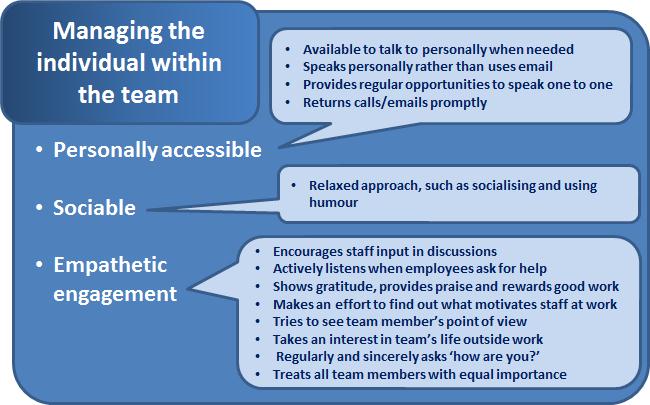
Managing and communicating existing and future work
- Proactive work management
- Problem solving
- Participative/empowering
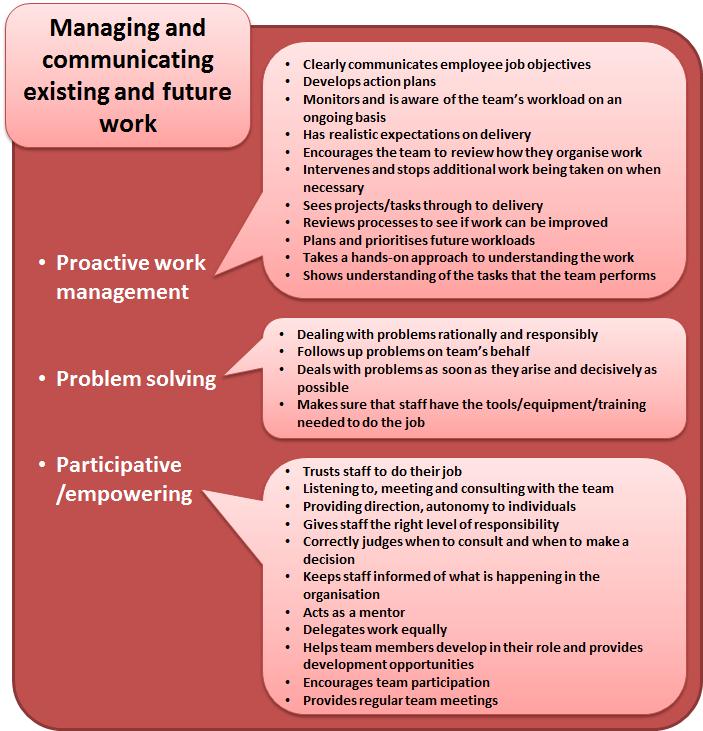
Respectful and responsible: managing emotions and having integrity
- Integrity
- Managing emotions
- Considerate approach
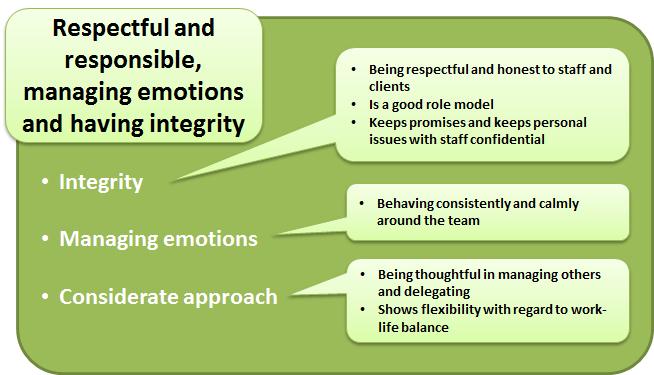
Reasoning/managing difficult situations
- Managing conflict
- Use of organisational resources
- Taking responsibility for resolving issues
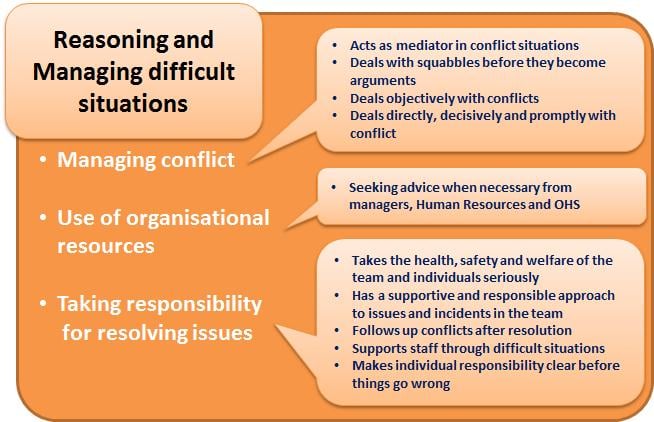
Resources and tools
- Management Competency framework with positive and negative behavioural indicators (PDF, 240.2 KB) (PDF, 257.7KB) A more comprehensive list of the characteristic behaviours of the competent supportive manager.
- Barriers to managers displaying positive behaviours and how they could be overcome (PDF, 0 Bytes) Ideas for managers on how to overcome some of the barriers to being a supportive manager
- Checklist to promote good supportive management (DOC, 0 Bytes)
- Senior Management Checklist (DOC, 0 Bytes) Simple checklist for senior management to promote supportive management with their managers
- Measure of manager behaviour: the self-questionnaire for managers (DOC, 116.0 KB)
What is an engaging job?
The more engaging and satisfying a job, the more resistant (but not immune) the staff member is to work related stress. Start by asking the following questions:
Does the job:
- Make a significant contribution to the completion of a product or service?
- Provide variety – in terms of pace, method, skill?
- Allow for some staff member discretion and control in the timing, sequence and pace of work efforts?
- Include some responsibility for outcome?
- Provide opportunity for relevant learning, problem-solving and personal development?
- Provide feedback on performance?
- Lead towards some desirable future?
If the answer to some of these questions are "no", what can be done to improve the situation?
It is rarely possible for jobs to be designed to incorporate all the characteristics listed above. Some will need to be traded off against others.
How much do you involve your Staff?
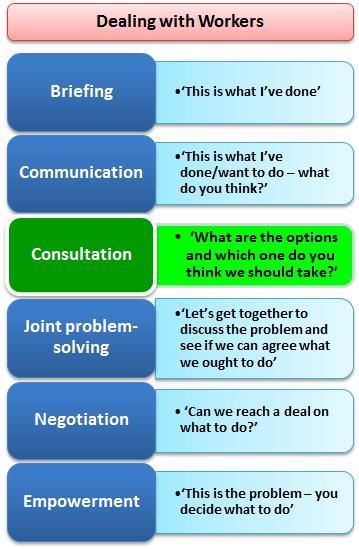
The OHS Act requires that employers through their managers and supervisors consult with staff on OHS matters (see OHS Manual: Staff consultation and representation). However consultation on OHS is only a small part of the spectrum of interactions between managers and their staff. Managers should be using the full range of interactions in their dealings with staff.
Consultation on matters that may affect staff OHS must be a two-way exchange between supervisors and staff that involves:
- sharing information about health and safety
- giving staff a reasonable opportunity to express their views, and
- taking those views into account.
Staff can be consulted in a variety of ways:
- when carrying out inspections or involving them in risk assessments
- when developing new procedures and safe work practices
- through an agenda item in regular meetings.
If staff have elected a health and safety representative (HSR), the HSR must be involved in consultation
A particular issue at Deakin is "distance management" where particularly direct line managers are not on the same campus as a portion of their staff. This can lead to two stress issues – staff feeling alienated from their manager (in the worst cases, "us" versus "them"), and the manager not being close enough to the workplace to feel the mood of local staff. This issue can be addressed in a number of ways that are dependent upon the situation:
- The use of local team leaders or campus representatives.
- Regular attendance, and more importantly, availability on the campus. Availability means leaving time outside the business schedule to catch up with people and socialise. This needs to be tempered with the stress of constant travel and the associated loss of time involved.
- The clustering when feasible of functions on a campus to warrant the appointment of a team leader
- The use of phone and to a lesser effect e-mail to keep in contact. The effectiveness of phone communications is dependant on the quality of the existing relationships. This in turn makes the induction process when these relationships are built critical.
- Where staff are having problems, then the amount of face-to-face contact needs to increase.
- Clear job and role expectations and objectives that are well understood by both you as the manager and the staff involved.
Sources and resources
Sources
- United Kingdom: Health and Safety Executive: Stress management competency indicator tool
- Chartered Institute of Personnel and Development : Line management behaviour and stress at work
Resources
- Stress management competency indicator tool: How effective are you at preventing and reducing stress in your staff? Line Manager Competency Indicator Tool (Interactive spreadsheet)
- United Kingdom ACAS (Advisory, Conciliation and Arbitration Service): Managing attendance and employee turnover
- The manager's role in the risk management of workplace stress - This guide provides advice and practical measures for the prevention and management of workplace stress
- Positive Mental Health at Work (video)
